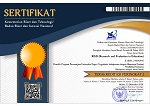The use of Malcolm Baldridge method for formulating strategic planning in the technological and vocational education
DOI:
https://doi.org/10.21831/reid.v1i2.6500Keywords:
Malcolm Baldrige, TVE, competitive strategy, quality improvement in educationAbstract
The article described the results of a study evaluating the performance of Technological and Vocational Education (TVE) by means of Malcolm Baldrige method. The data on the performance was used in order to know its excellence and weakness. Based on the performance excellence and weakness, a competitive strategy could be formulated in order to improve the TVE quality. First, performance measurements by means of Malcolm Baldrige criteria were done on seven study programs from different universities. Second, results of the performance measurements were analyzed and described. With the data resulting from the performance measurements as the basis of the analysis, the excellence and weakness of TVE performance might be found. Third, a strategy was developed. Based on the performance excellence and weakness, a performance improvement strategy might be formulated in order to raise the quality level within the educational process of TVE. The research results indicated that for the performance level the seven universities under measurement achieved scores ranging from 526 to 711 point. These results showed that the performance of study programs in TVE within Indonesia put these study programs into the categories of education leader and of emerging education leader. On the basis of those categories, each study program might formulate its own competitive strategy in order to improve the TVE performance so that the educational process being conducted might also improve in terms of quality level.References
Abraham , S.,C. (2006). Strategic Planning: A Practical Guide for Competitive success. London: Thompson South-Western.
Allio, R. (1998). The practical srategiest: Business and corporate strategy for the 1990. Social Science-Elsevier, 21, 104-1011.
Allison, M., & Kaye J. (2005). Strategic planning for nonprofit organizations: A practical guide and workbook (2nd ed.). Maitland: Wiley
Bambang Swasto. (1996). Pengembangan Sumber Daya Manusia Terhadap Kinerja dan Imbalan, Cetakan Pertama, Universitas Brawijaya Malang.
Brown, Mark Graham. (2008). Baldrige Award Winning Quality, Seventeenth Edition United State of America.
Bryson, J., M. (1999). Perencanaan strategis bagi organisasi nirlaba. Yogyakarta: Pustaka Pelajar
Cooper, D.R. & William, E.C. (1996). Metode penelitian bisnis. Erlangga: Jakarta.
Depdiknas. (2010). Sistem Penjaminan Mutu Perguruan Tinggi. Jakarta: Dikti.
Eko Indrajit, R., & Djokopranoto, R. (2005). Manajemen Strategis Perguruan Tinggi. Jakarta: Universitas Atmajaya.
Gaspersz, & Vincent. (2011). Malcolm Baldrige Criteria for Performance Excellence: Contoh Aplikasi Pemenang Malcolm Baldrige Award. Bogor: Vinchristo Publication.
Handoko, T.H. 2003. Manajemen. Yogyakarta: BPFE.
Harry, S., Hertz. (2011). Criteria for Performance Excellence. Diambil pada tanggal 6 November 201. http://www.nist.gov
Kaplan, R.S, & Norton D.P. (1996). Translating Strategy into Action : The Balanced Scorecard. Boston: Harvard Business School Press.
Leslie, R. (2005). The art of Trining and Development: EFECTIVE PLANNING. Jakarta: Gramedia Pustaka Utama.
National Institute of Standards and Technology. (2000). Baldrige National Quality Program 2000 Education Criteria for Performance Excellence. NIST, Maryland.
Prosser, C.A. & Quigley, T.H. (1950). Vocational Education in a Democracy. Revised edition. Chicago: Amerian Technical Society.
Ridwan, A.S. (2008). Majamen mutu. Medan: USU.
Warzynski, C. (2001). How can the balanced scorecard improve performance at your institution?. Pennsylvania: Pennsylvania State University.
Wheelen, T.L. & Hunger, J.D. (1996). Strategic management (5th ed.). Boston: Addison Wesley Publishing Company.
Wikipedia. (2008). Vocational education and training. Diambil pada tanggal 3 Agustus 2011, dari http://en.wikipedia.org/wiki/Vocational_Education_ and_Training
Zohrabi, A. & Manteghi, N. (2011). A proposed model for strategic planning in educational organizations. Social Science-Elsevier,76, 205- 210.
Downloads
Published
How to Cite
Issue
Section
License
The authors submitting a manuscript to this journal agree that, if accepted for publication, copyright publishing of the submission shall be assigned to REiD (Research and Evaluation in Education). However, even though the journal asks for a copyright transfer, the authors retain (or are granted back) significant scholarly rights.
The copyright transfer agreement form can be downloaded here: [REiD Copyright Transfer Agreement Form]
The copyright form should be signed originally and sent to the Editorial Office through email to reid.ppsuny@uny.ac.id

REiD (Research and Evaluation in Education) by http://journal.uny.ac.id/index.php/reid is licensed under a Creative Commons Attribution-ShareAlike 4.0 International License.






.png)





